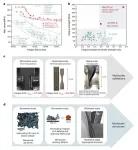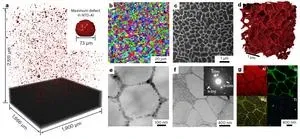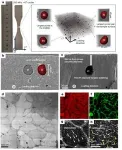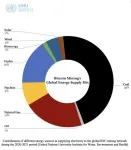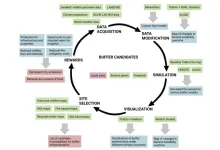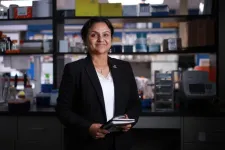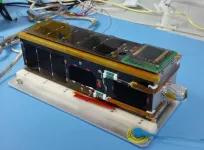(Press-News.org) It is estimated that over 80% of engineering failures are due to material fatigue, so the fight against metal fatigue failures continues, as this is a key parameter for lightweight structures for all mechanical systems, such as aircraft, automobile and energy-production systems. Recently, joint research by City University of Hong Kong (CityU) and Shanghai Jiao Tong University achieved a breakthrough by creating an aluminium alloy with unprecedented fatigue resistance using advanced 3D printing techniques. The new fatigue-resistance strategy can be applied in other 3D-printed alloys to help develop lightweight components with increased load efficiency for various industries.
“The fatigue phenomenon in metals was discovered about two centuries ago. Since then, fatigue failure has become one of the most important issues in the lifespan and reliability of all dynamic mechanical systems, such as those in aircraft, automobiles and nuclear power plants,” said Professor Lu Jian, Dean of College of Engineering, and Director of the Hong Kong Branch of the National Precious Metals Material Engineering Research Center (NPMM) in CityU, who co-led the research.
Conventional metals exhibit fatigue strength generally lower than half their tensile strength. “Low fatigue strength is caused mainly by multi-scale defects in the materials, which continue to grow and evolve with cyclic loading, forming macroscopic cracks and expanding eventually into larger cracks that destroy the entire material structure,” he explained. “This challenging phenomenon also happens in alloys produced by additive manufacturing, also known as 3D-printing, limiting further applications of 3D-printed materials.”
To overcome the issue of low fatigue resistance in 3D-printed alloys and generally in all metal materials, a joint-research team of CityU and Shanghai Jiao Tong University used Laser Powder Bed Fusion (LPBF) – one of the most widely used metal additive manufacturing techniques – to successfully fabricate a novel aluminium alloy from AlSi10Mg powders decorated with TiB2 nanoparticles. The fatigue resistance of this 3D-printed nano-TiB2-decorated AlSi10Mg (NTD-Al alloy) is more than double that of other 3D-printed aluminium alloys and surpassed those of high-strength wrought AI alloys.
The findings were published in Nature Materials under the title “Achieving ultrahigh fatigue resistance in AlSi10Mg alloy by additive manufacturing”. And they were featured in the “Research Highlights” of the prestigious scientific journal Science, which described it as a general strategy for other alloys to boost fatigue resistance.
The team used micro-computed tomography to investigate this 3D-printed NTD-Al alloy and found throughout the sample a typical continuous 3D-dual-phase cellular nanostructure, which consisted of a network of solidification cellular structure with an average diameter of about 500 nanometers. The 3D-dual-phase cellular nanostructure acts as a strong volumetric nanocage to prevent localized damaged accumulation, inhibiting fatigue crack initiation.
“The three-dimensional network of nano eutectic silicon (Si) generated by additive manufacturing inside the alloy due to rapid solidification could block the movement of dislocations, thus suppressing fatigue crack initiation,” said Professor Lu. “With controlled defects through process optimisation, the fatigue limit of the bulk NTD-Al alloy is superior to that of all existing Al alloys.”
In a series of fatigue tests, the research team found that the printed bulk NTD-Al alloy achieved fatigue resistance of 260 MPa, which was more than double that of other additive manufacturing Al alloys. The high fatigue strength limit of the bulk NTD-Al alloy surpassed that of all other Al alloys, including conventional high-strength wrought Al alloys with limited metallurgical defects.
The NTD-Al alloy has already been applied to fabricate prototypes of large thin-walled structures, including the fan blades of aircraft engines designed for high fatigue strength, and successfully passed the qualifying fatigue test.
“These findings indicate the potential applicability of our alloy for the lightweight structures necessary in industries where fatigue properties are the key design criterion. Our alloy can help reduce weight by increasing the load efficiency of moving components,” added Professor Lu.
Combined with the advantages of 3D printing, the latest discovery will boost lightweight design and reduce carbon emissions in modern industries. And the same strategy can be also used for other materials to help solve the fatigue failure challenge in metal additive manufacturing,” concluded Professor Lu Jian.
The study was a collaboration between Professor Wang Haowei’s and Professor Lu’s teams. The co-first authors of the paper are Dr Dan Chengyi, Assistant Professor Cui Yuchi, Associate Professor Wu Yi and Professor Chen Zhe from Shanghai Jiao Tong University. The co-corresponding authors are Professor Lu from CityU and Professor Chen. Also participating in the study was Dr Liu Hui, former postdoc in the Department of Mechanical Engineering at CityU.
This research was supported by the National Natural Science Foundation of China, the Conseil Regional du Nord-Pas de Calais, and the European Regional Development Fund.
https://www.cityu.edu.hk/research/stories/2023/10/20/cityu-joint-research-creates-3d-printed-aluminium-alloy-unprecedented-fatigue-resistance
END
CityU joint research creates 3D-printed aluminium alloy with unprecedented fatigue resistance
2023-10-24
ELSE PRESS RELEASES FROM THIS DATE:
Certain per- and polyfluoroalkyl “forever chemicals” identified as potential risk factor for thyroid cancer
2023-10-24
Mount Sinai researchers have discovered a link between certain per- and polyfluoroalkyl substances (PFAS) and an increased risk for thyroid cancer, according to a study published in eBioMedicine today.
PFAS, also known as “forever chemicals,” are a large, complex group of synthetic chemicals that can migrate into the soil, water, and air. Due to their strong carbon-fluorine bond, these chemicals do not degrade easily in the environment. Forever chemicals been used in consumer products around the world since the 1940s, including nonstick cookware, water-repellent clothing, stain-resistant fabrics, and other products that resist grease, water, and oil.
Multiple national and international ...
UN study reveals the hidden environmental impacts of bitcoin: Carbon is not the only harmful byproduct
2023-10-24
Hamilton, Canada: The extraordinary rise in cryptocurrency prices over the previous decade has prompted huge investments in the cryptocurrency sector. Undeniably, digital currencies have won the faith of the world's top investors, ranging from large corporations and tech millionaires to criminals, money launderers, and sanction busters.
Thanks to blockchain and other technological breakthroughs, digital currencies now constitute an advanced element of the world’s modern financial ...
Study: School debate programs linked to improvements in academic achievement, graduation rates, and college enrollment
2023-10-24
Washington, October 24, 2023—Participating in policy debate programs in middle and high school is associated with improvements in English language arts (ELA) achievement and increases in the likelihood that students graduate from high school and enroll in postsecondary education, according to new research. The study was published today in Educational Evaluation and Policy Analysis, a peer-reviewed journal of the American Educational Research Association. It was conducted by Beth Schueler from the University of Virginia and Katherine Larned from Harvard University.
Video: Study co-author Beth Schueler discusses ...
Banana trees to fight wildfires
2023-10-24
Fire buffers composed of irrigated banana trees could slow and calm wildfires and generate profit for residents of fire-prone regions, according to a study. Climate change is increasing wildfire risk. Wildfires in the Western United States doubled in frequency between 1984 and 2015. At the same time, more people are living in the wildland-urban interface (WUI) than ever before, an area that often has high or extreme fire risk. Barath Raghavan and colleagues investigate the potential of banana trees to act as a multifunctional fire buffer in the WUI. Banana trees have a high water content, ideal for stopping fire. When irrigated by recycled water, they can produce ...
Study shows engineered gut bacteria can treat hypertension
2023-10-24
Scientists at The University of Toledo have proven that engineered bacteria can lower blood pressure, a finding that opens new doors in the pursuit of harnessing our body’s own microbiome to treat hypertension.
The study, published this month in the peer-reviewed journal Pharmacological Research, represents a paradigm shift, said Dr. Bina Joe, a hypertension researcher at UToledo and the paper’s senior author.
“The question we always ask is, can we exploit microbiota to help our health, for which optimal blood pressure is a cardinal sign. Until now, we have simply said ...
Light, freshwater sticks to Greenland's east coast
2023-10-24
Meltwater that runs along the east coast of Greenland, hardly enters the open ocean before reaching the western side of the island. That is one of the conclusions NIOZ PhD-candidate Elodie Duyck draws in the thesis she is defending today at Utrecht University. In the changing climate, fresh water from Greenland and the Arctic could disrupt the circulation in the Atlantic Ocean. “Understanding where, and how much, of that fresh and light water enters the Atlantic Ocean is critical to predict how the circulation may evolve under climate change”, Duyck ...
Older adults from distressed communities attend less cardiac rehab after heart procedures
2023-10-24
Older adults who live in disadvantaged communities are less likely to attend cardiac rehabilitation after common heart procedures, a Michigan Medicine-led study finds.
The study aimed to calculate how many Medicare beneficiaries attended cardiac rehabilitation, a medically supervised program exercise and education program, after coronary revascularization between mid-2016 and 2018.
Patient communities were categorized using the Distressed Community Index, which analyzes economic well-being and social determinants of health, such as educational disparities and poverty rate, of United States zip codes.
Only ...
Finding the genes that help kingfishers dive without hurting their brains
2023-10-24
If you’ve ever belly-flopped into a pool, then you know: water can be surprisingly hard if you hit it at the wrong angle. But many species of kingfishers dive headfirst into water to catch their fishy prey. In a new scientific study in the journal Communications Biology, researchers compared the DNA of 30 different kingfisher species to zero in on the genes that might help explain the birds’ diet and ability to dive without sustaining brain damage.
The type of diving that kingfishers do-- what researchers call “plunge-diving”-- is an aeronautic feat. “It’s a high-speed dive from air to water, and it’s done by very few bird species,” says ...
Two regions of the brain critical to integrating semantic information while reading, UTHealth Houston research finds
2023-10-24
Two different regions of the brain are critical to integrating semantic information while reading, which could shed more light on why people with aphasia have difficulty with semantics, according to new research from UTHealth Houston.
The study, led by first author Elliot Murphy, PhD, postdoctoral research fellow in the Vivian L. Smith Department of Neurosurgery with McGovern Medical School at UTHealth Houston, and senior author Nitin Tandon, MD, professor and chair ad interim of the department in the medical school, was published today in Nature Communications.
Language depends largely on the integration of vocabulary across multiple words ...
Solar farms in space are possible, say Surrey and Swansea
2023-10-24
It's viable to produce low-cost, lightweight solar panels that can generate energy in space, according to new research from the Universities of Surrey and Swansea.
The first study of its kind followed a satellite over six years, observing how the panels generated power and weathered solar radiation over 30,000 orbits.
The findings could pave the way for commercially viable solar farms in space.
Professor Craig Underwood, Emeritus Professor of Spacecraft Engineering at the Surrey Space Centre at the University of Surrey, said:
“We are very pleased that a mission designed to last one year is still working after six. These detailed data ...
